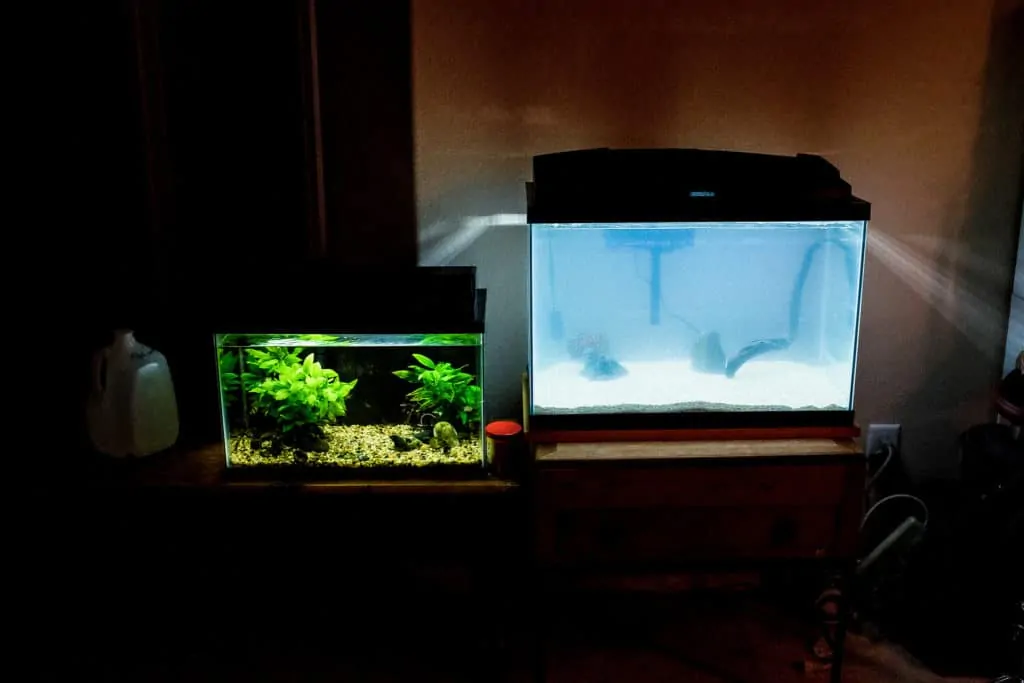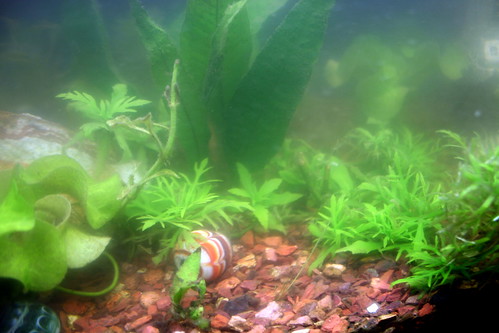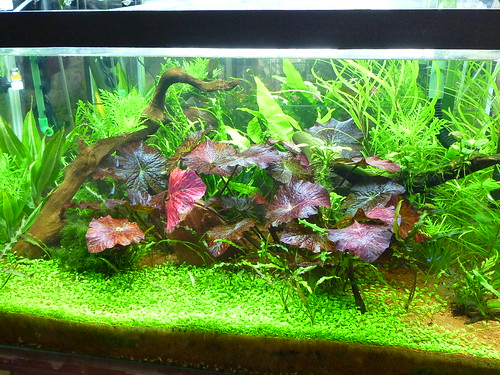It can be rather puzzling when the water in a new or established aquarium turns cloudy all of a sudden. You may find yourself asking: is cloudy water normal, what is causing it, should you be worried, and how do you fix a cloudy aquarium? There are a few factors that could cause your tank water to suddenly become cloudy, including the kind of water you use to do a water change as well as how much food you give your fish.
Luckily, there are ways to prevent your aquarium water from becoming cloudy and some pretty easy fixes if this ever happens to your tank!
Keep reading to find out why your fish tank water is cloudy, how you can fix cloudy aquarium water, and how to prevent any future cloudiness problems altogether!
Cloudy aquarium water: causes & solutions
In a new aquarium, cloudy water is perfectly normal and usually nothing to worry about, as any dust or other cause has plenty of time to settle and correct itself during the cycling process. If cloudy water occurs in an established tank, there might be something worse going on that needs immediate attention.
Here we will discuss what could cause your tank to become cloudy and how to make your water crystal clear again:
Unrinsed substrate
The single most common cause of cloudy water in a new tank is an unrinsed or improperly rinsed substrate. It doesn’t matter what type of substrate you choose, they almost always contain a certain amount of dust that is released when mixed with your aquarium water. The cloudiness should settle on its own or be caught by your filter within a few days. If it’s taking longer than that for the water to clear, perhaps do a small water change and make sure your filter is functioning properly.
To help prevent this, you can wash your aquarium substrate by placing it in a bucket, adding water to stir up the dust, and discarding the cloudy water. Repeating this a few times can really help lessen the amount of dust but it’s almost impossible to prevent a few days of water cloudiness. Another way to do this is by poking tiny holes in the substrate bag and running it under water and helping wash away the dust that way. Getting pre-washed substrate can also help to at least reduce initial water cloudiness, and maybe the preferred choice if replacing substrate for an already established tank.
It is important to remember that anytime you want to change around the decor in your new tank, it will also lead to that dust being kicked up and might cause cloudy water for a few hours. So try not to stir up the bottom too much by making sure you have a definite aquascape plan for your new aquarium!
Bacterial bloom
Aquarium water suddenly turning milky white and cloudy can be a sign of a bacterial bloom in both a new and established tank. The bacteria we’re talking about here are the same ammonia and nitrite consuming types that normally occur in your filter and surface area of your tank; the cloudy water is just due to a lot more bacteria swimming freely in the water than usual. These tiny bacteria are not inherently dangerous to fish or invertebrates, but they do point to a more urgent issue: an amount of ammonia so high that your filter is unable to deal with it.
In a cycling and fishless new aquarium, a bacterial bloom is normal; the bacteria in your tank are growing (that’s what you want!), but haven’t had the time to become fully established yet. In this case, the cloudiness of your water should disappear when your aquarium is cycled and there are enough bacteria in the filter and in your tank to deal with the high ammonia and nitrite levels.
In an established tank set up with fish, a bacterial bloom is a worrying sign: test your water for all parameters immediately. Something has disrupted the natural cycle in your tank–possibly carbon or vinegar dosing–and it is possible for ammonia and nitrite to quickly spike, affecting any fish or other livestock you may have.
If this is the case, be sure to immediately perform a partial water change and test regularly until water values are normal. Continue doing partial water changes until the cloudy water has turned clear and/or your levels return to normal. Also, stop dosing any vinegar or carbon as the bacteria could be using these as a food source and may be the cause of your cloudy aquarium; it is also possible that you didn’t rinse the carbon in your filter thoroughly enough, so make sure to do this before putting new carbon in your filter. You can also dose extra nitrifying bacteria to speed up the process and clear the aquarium water more quickly, just make sure to dose your tank accordingly.
The prevention section below discusses how to prevent an ammonia spike in your tank and the resulting bacterial bloom.
Algal bloom
Green and cloudy water are most likely caused by free-floating algae particles, which thrive when there is an overload of nutrients and light in the tank system.
Make sure to not set up a new tank in direct sunlight. If your aquarium is getting too much natural light, move it to a place where no direct sunlight hits it. Adjust your lighting schedule if your aquarium lights are on for a long time every day and try lowering the intensities if possible. In extreme cases, you can even leave the lights off on your tank completely for a few days (your fish will be fine, but you may lose a plant or two). This is called a blackout and a very common method of eliminating an algae bloom. However, it is important to also find out and fix the main problem that originally caused the cloudy water in your tank while performing the blackout.
Take a good look at your water values and tank maintenance schedule as well: are your nitrate and phosphate levels high? Are your tap water values less than ideal? Are you doing water changes, removing debris and waste, and cleaning your filter regularly? Once aquarium light, maintenance, and water values are where they’re supposed to be, green and cloudy aquarium water should usually clear up in a few days.
Live plants actually compete with algae for nutrients and growing them in your aquarium can also help reduce or prevent problems with having green cloudy water in your aquarium.
Tap water vs. RODI/distilled water
If you’re still using tap water to do water changes or to top off your tank water level, stop. This is most like the cause of your problems if you’re experiencing an algae bloom or having cloudy aquarium water. Tap water contains a lot of unknowns: there are usually phosphates, heavy metals, and traces of other nutrients and elements that are undesirable to use as fish tank water. The only way to know exactly what is in your tap water is by sending off a sample to a laboratory for a full report.
On the other hand, RODI/distilled water guarantees that nothing but water is entering your aquarium system, so you don’t have to worry about excess phosphates or other nutrients/elements that could affect the overall health of your fish and lead to cloudy water. Plus, RODI/distilled water is very easy to find and affordable! Most grocery and pharmacy stores carry distilled water and might even offer a fill-your-own jug water station. It is likely that your local fish store carries RODI water, or you can even get your own system if you’re going to be in the aquarium hobby for long.
Both water options are definitely worth checking out if you want to have a long-running and healthy aquarium!
Other reasons for cloudy aquarium water
Murky or white cloudy water in an established aquarium setup is a sign that there is something seriously fundamentally wrong with your equipment, livestock, feeding habitat, or maintenance. Here we will discuss what else could cause cloudy water in your aquarium besides some type of algal or bacterial bloom:
Equipment malfunction
If your crystal clear tank water changes to almost opaque overnight, immediately check to see if your filter or any other aquarium equipment has malfunctioned. There is a chance that one of the inner mechanics has broken and is causing the machine to not work to its full capacity. It is also possible that algae are blocking the intake and/or output of your filter or powerhead, slowing down how much water is being cycled and returned into the tank, leading to cloudy water. An easy way to fix and prevent this is by regularly cleaning all aquarium equipment approximately every six months and removing any excess algae when first noticed.
Overstocking
If your filter and other equipment are still working at their optimal rates and functioning well, then you may have a problem with your choice of livestock. Step back from your tank and take an honest look: is your tank overstocked with fish? It can be especially easy for beginners to fill their new tank with as many fish as fast as they can and as quickly as they can, but this will ultimately cause the tank to fail in a very short amount of time. Too many fish or too big of fish can cause massive amounts of waste and subsequent ammonia spikes that can lead to cloudy water. Even the biggest filter won’t be able to keep up with an overstocked tank!
One of the main culprits of causing cloudy aquarium water due to their waste is goldfish. They are notorious for creating huge amounts of ammonia that quickly become lethal even if they are not put in an overstocked tank. If you’re thinking about setting up a goldfish tank, the amount of waste they produce is definitely something to consider. You can read more about keeping and setting up a goldfish tank here.
Overfeeding
Similar to overstocking, overfeeding introduces a lot of excess nutrients and subsequent waste into the water. If you don’t have the necessary cleanup crew or filter to keep up with how much you are feeding, this can easily lead to having cloudy water in your tank. The easiest way to fix this is by first cutting down on the amount of food you’re feeding. Most fish food is actually very high in crude protein, and your fish and invertebrates don’t need that much to thrive. Some aquarium keepers feed twice a day while others feed every other day; you should find a schedule that works best for your tank that doesn’t cause cloudy aquarium water.
If you experience cloudy aquarium water due to excess fish food, do a partial water change and change your filter pad. This should help clear things up in a couple of days as long as you are not continuing to give as much food.
Maintenance (water changes and cleaning)
One of the ways to have a successful fish tank without cloudy water is to perform regular tank maintenance. On top of cleaning your filter and other aquarium equipment, it is important to stay on top of water changes and siphoning the substrate. Weekly or biweekly partial water changes help replace and remove any trace nutrients and elements in your tank; this can help prevent an algal or bacterial bloom before it happens while keeping your plants and fish supplemented with fresh water. Siphoning the substrate will also remove any waste that has accumulated, potentially preventing algae from growing in those spots and later spreading throughout the tank making for a cloudy fish tank.
Besides manually cleaning your filter, it is also important to regularly change the carbon and filter pad. A lot of waste and fish food gets caught in the filter pad, so it should be changed or removed entirely a few days after every partial water change. The carbon should also be replaced every 3-4 weeks to make sure that it hasn’t filled up and is still removing impurities from the water and keeping your fish tank clear.
Cloudy aquarium water: prevention
To help prevent cloudy aquarium water and the associated problems, make sure the following are in order:
Cycle
Your new aquarium should always be fully cycled before introducing any fish or invertebrates. An uncycled or currently cycling aquarium is subject to ammonia and nitrite spikes and can lead to a bacterial bloom and a cloudy fish tank; not to mention that both of the former are toxic to fish and invertebrates! Everything you need to know about cycling a new tank–how to start a cycle in a new aquarium, what is chemically happening to the water, and how to prepare for your first fish–can be found here.
Stock
Your aquarium must be properly stocked. Overstocking (with fish that are too large or too many fish) can lead to serious problems with cloudy water and can cause an algal or bacterial bloom as a result of excessive fish waste output. Always plan out the fish and invertebrates you want first and don’t introduce too many new fish at once. You can find some helpful aquarium stocking tips here.
Filter
An aquarium should always have a filter that cleans and overturns water in order to sustain its cycle. Your filter should be able to handle more than the amount of waste your fish currently produce and contain the right filter media depending on what you have in the tank. Never turn your filter off for more than an hour at a time and never replace all your filter media at once if you don’t want to cause cloudy aquarium water and/or a bacterial bloom. Everything you need to know about choosing and maintaining an aquarium filter can be found in these articles.
Maintenance (water changes and cleaning)
Proper aquarium maintenance is always a must to ensure healthy fish, invertebrates, and plants. Do regular water tests and perform a weekly or biweekly water change depending on your stock and aquarium size. Remove any waste and debris, like leftover fish food, dead plant bits, and other decaying matter that could potentially cause many water problems if not siphoned off the bottom of your fish tank. If you have rocks or driftwood, you should also turkey baster hard-to-reach places, and suck up the waste that enters the water for especially clear water.
Medications
Some fish medication types can impede your water cycle, resulting in a new cycling process with ammonia and nitrite spikes and a likely bacterial bloom in your tank. Check whether the medication is safe first and if it isn’t, treat your fish or invertebrate in a quarantine tank where water fluctuations can be monitored won’t affect everything else.
Conclusion
Cloudy aquarium water can be a real headache especially if everything you suspect isn’t the main cause of the problem. This will leave you scratching your head as to what is the matter with your aquarium. The best thing to do during these times is to not get frustrated; it is very tempting to just give up and walk away from the hobby entirely, and unfortunately, this happens more often than not.
Accept that your fish tank is going to need some TLC and get to finding the root of the problems: test every water parameter you can and buy tests kits for the ones you don’t already have; actually look into the aquarium daily and note any physical changes that have happened over the past 24 hours; perform a water change with RODI/distilled water and up your maintenance to at least one partial water change per week; make sure that all aquarium equipment is working correctly; cut back on the amount of food you give and hopefully your aquarium water will start to clear up.
It will take some time and you may never know the answer as to why your fish tank water became cloudy in the first place, but it’s definitely not a reason to give up on this amazing hobby! This is all part of the process.
If you have any more questions about cloudy aquarium water or if you want to share your own experiences dealing with imperfect aquarium water, don’t hesitate to leave a comment below!






Using filter floss is a good way to catch up all the particulate matter as well. I use it in my largest tank which I’m feeding quite a lot to grow my fish a bit. Maybe this will be useful for those with cycled aquariums to help improve clarity 🙂